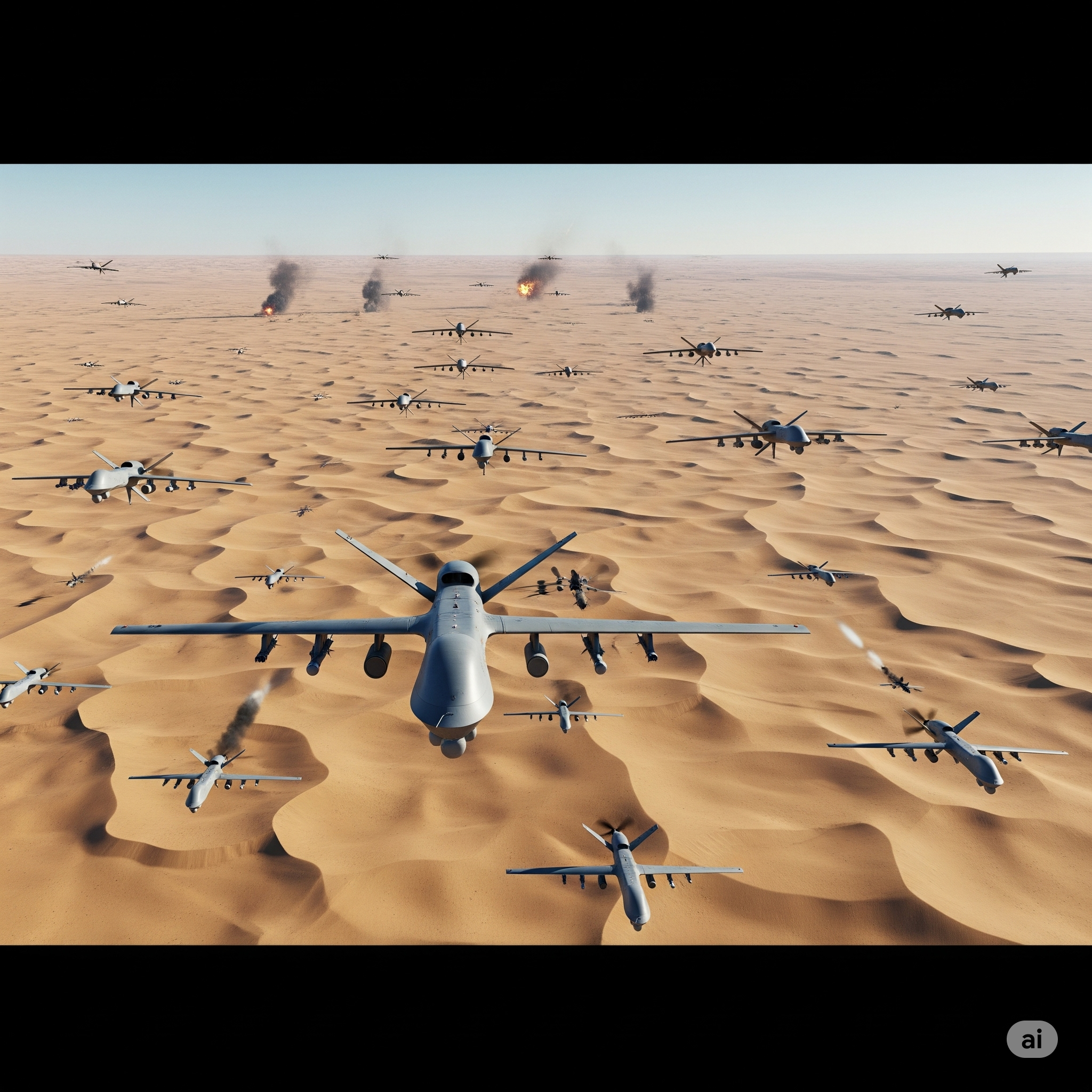In- short:
- The recent Operation Spider Web drone attack reveals a paradigm shift in modern warfare, showcasing the role of autonomous systems and coordinated drone swarms.
- The sophistication of this attack indicates a new era of hybrid, AI-powered, and unmanned warfare.
- India’s preparedness for such technologically advanced attacks remains in question, with both opportunities and vulnerabilities to consider.
- Integration of AI, cyber capabilities, robotics, and quantum tech is vital for India’s future military posture.
Introduction
On the battlefield of the future, soldiers may be replaced or complemented by fleets of intelligent drones. The recent global attention on “Operation Spider Web” — a highly coordinated, multi-drone attack showcasing precision, stealth, and AI-driven decision-making — has shocked defense strategists worldwide. As such technological warfare becomes reality, the pressing question emerges: Is India ready for this shift in military doctrine and capability?
This blog explores the implications of drone warfare through the lens of Operation Spider Web, evaluates India’s current defense technology posture, and discusses what lies ahead for our armed forces in an era where software could be as decisive as soldiers.
Understanding Operation Spider Web: A Glimpse into Future Warfare
The phrase “Operation Spider Web” refers to a sophisticated drone-based military attack involving synchronized swarms of autonomous UAVs (Unmanned Aerial Vehicles). What made the operation notable:
- Swarm Intelligence: Multiple drones coordinated like a neural network.
- AI Navigation: Capable of changing flight paths based on real-time threats.
- Targeted Precision: Able to strike sensitive, moving targets.
- Minimal Human Intervention: Operated remotely or autonomously.
Outcome: High success rate with minimal collateral damage, showcasing how drones, software, and real-time intelligence could replace traditional boots-on-ground.
Changing Nature of Warfare: From Conventional to Cyber-Physical Battlespaces
Traditional warfare relied on manpower, tanks, and brute force. Today, war is becoming:
- Asymmetric: Small forces can cripple large infrastructure.
- Hybrid: A mix of conventional, cyber, information, and drone tactics.
- Automated: Using robotics, AI, and predictive algorithms.
The implication is clear: speed, data, and precision matter more than just size and numbers.
Where Does India Stand in the Technological Arms Race?

India’s military is strong in manpower and growing in mechanized power. But when it comes to AI, autonomous systems, and integrated tech, gaps remain.
Strengths:
- DRDO-developed drone systems like Rustom.
- Startups contributing to drone and AI defense tech.
- ISRO’s technological support in navigation and satellite imaging.
Challenges:
- Lack of a unified military tech doctrine.
- Dependence on imports for high-end defense hardware.
- Slow integration of AI, quantum, and autonomous tech.
- Limited testing of coordinated swarm drones in real scenarios.
Lessons from Operation Spider Web for India
India must understand that future conflicts may not involve territory, but infrastructure, data, and perception.
What India can learn:
- Swarm Coordination: Develop or acquire tech enabling dozens of drones to act as a single coordinated entity.
- AI Integration: Algorithms that allow decision-making mid-mission.
- Low-Latency Communication: Use 5G/6G and satellite links for secure, uninterrupted control.
- Counter-drone Systems: Anti-drone jammers, EMP weapons, or drone-on-drone defense.
Can India’s Defense Industrial Complex Rise to the Challenge?
India’s defense manufacturing has improved under the “Make in India” and “Atmanirbhar Bharat” initiatives, but high-tech sectors still need boosts in:
- R&D Funding: Public-private partnerships.
- Talent Acquisition: Incentivize Indian AI and robotics talent to stay and innovate locally.
- Collaborations: With nations like Israel, Japan, and France on tech-focused military R&D.
- Dual-Use Innovation: Military-civil fusion to make AI systems scalable and modular.
Ethical and Geopolitical Considerations
While India pursues these advancements, questions arise:
- Will autonomous drones comply with international laws?
- How will AI mistakes be evaluated in war scenarios?
- Can India maintain ethical boundaries while adversaries do not?
Moreover, as drones reduce the cost of entry into warfare, non-state actors could use similar technology, forcing India to improve counter-terrorism capabilities.
The Role of AI and Quantum Tech in India’s Defense Future
AI is only one part. Quantum radar, satellite-linked communications, and real-time battlefield simulation are equally critical.
Steps forward:
- Establish AI-based Combat Command Systems.
- Use quantum encryption for military comms.
- Launch indigenous AI accelerators for startups focused on defense.
Public-Private Synergy: A Need, Not a Choice
Global defense innovation increasingly comes from startups and academia. India must:
- Leverage talent from IITs, IISc, and AI labs.
- Support innovation hubs like iDEX.
- Remove red tape for military-tech startups.
Conclusion: The Future Is Not Optional — It’s Inevitable
Operation Spider Web isn’t science fiction – it’s a warning and an opportunity. India has the brainpower, potential, and willpower. But time is short.
To be a global power in the 21st century, India must:
- Build a resilient, tech-savvy military.
- Partner wisely.
- Invest heavily.
- Balance ethics with necessity.









+ There are no comments
Add yours